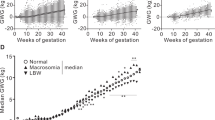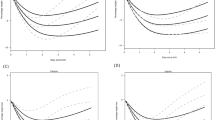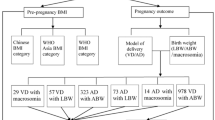Abstract
Background
To describe the pattern of gestational weight gain (GWG), derive reference centiles for GWG specific to North Indian population, and to compare the weight gain across different periods of gestation with the INTERGROWTH–21st reference.
Methods
A prospective pregnancy (GARBH-Ini) cohort was initiated and followed between May 2015 and June 2019 in a district hospital, Gurguram, North India. GWG centile curves were modelled by Generalized Additive Models for Location, Scale and Shape method (n = 2844) and compared with INTERGROWTH-21st reference. The independent association of GWG with biological and social predictors was assessed using multivariable regression analysis.
Results
Percentiles (3rd, 10th, 50th, 90th and 97th) for each completed week from 18–40 weeks of gestation were derived from smoothed centile curves. The median GWG across pregnancy during specific antenatal visits was 1.29 at 18, 4.44 at 26, 5.8 at 30 and 9.06 kg at 40 weeks of gestation. Nearly 26% of participants had GWG < 10th centile at 18–20 weeks as per INTERGROWTH–21st reference and this increased to 45% at delivery. Significant predictors of GWG included maternal age, height, first trimester body mass index, parity, type of family, and use of clean fuel for cooking.
Conclusion
These GWG percentiles will serve as a useful reference, particularly during the WHO recommended antenatal visit schedule for optimum pregnancy outcomes, for clinicians and researchers. Multiple independent biological and social predictors of GWG suggest that single interventions are unlikely to bridge the gap between general Indian population and international references.
This is a preview of subscription content, access via your institution
Access options
Subscribe to this journal
Receive 12 print issues and online access
$259.00 per year
only $21.58 per issue
Buy this article
- Purchase on Springer Link
- Instant access to full article PDF
Prices may be subject to local taxes which are calculated during checkout



Similar content being viewed by others
Data availability
Data described in the manuscript will be made available upon request pending approval.
Code availability
Analysis code will be made available upon request with the objective of use.
References
Kominiarek MA, Peaceman AM. Gestational weight gain. Am J Obstet Gynecol. 2017;217(Dec):642–51.
Institute of Medicine (US) and National Research Council (US) Committee to Reexamine IOM Pregnancy Weight Guidelines. Weight Gain During Pregnancy: Reexamining the Guidelines [Internet]. Rasmussen KM, Yaktine AL, editors. Washington (DC): National Academies Press (US); 2009 [cited 2019 Jul 25]. (The National Academies Collection: Reports funded by National Institutes of Health). Available from: http://www.ncbi.nlm.nih.gov/books/NBK32813/.
Cheikh Ismail L, Bishop DC, Pang R, Ohuma EO, Kac G, Abrams B, et al. Gestational weight gain standards based on women enrolled in the Fetal Growth Longitudinal Study of the INTERGROWTH-21st Project: a prospective longitudinal cohort study. BMJ. 2016;i555.
Arora P, Tamber Aeri B. Gestational Weight Gain among Healthy Pregnant Women from Asia in Comparison with Institute of Medicine (IOM) Guidelines-2009: A Systematic Review. J Pregnancy. 2019;2019(Mar):1–10.
Bhatnagar S, Majumder PP, Salunke DM. A pregnancy cohort to study multidimensional correlates of preterm birth in india: study design, implementation, and baseline characteristics of the participants. Am J Epidemiol. 2019;188(Apr):621–31.
WHO MULTICENTRE GROWTH REFERENCE STUDY GROUP, Onis M. Reliability of anthropometric measurements in the WHO Multicentre Growth Reference Study: WHO Multicentre Growth Reference Study Group. Acta Paediatrica. 2007;95(Jan):38–46.
Stasinopoulos MD, Rigby RA, Heller GZ, Voudouris V, Bastiani FD. Flexible regression and smoothing: Using GAMLSS in R (1st ed.) 2017. Chapman and Hall/CRC, Boca Raton. p. 572. https://doi.org/10.1201/b21973.
Villar J, Altman D, Purwar M, Noble J, Knight H, Ruyan P, et al. The objectives, design and implementation of the INTERGROWTH-21st Project: The INTERGROWTH-21st Project. BJOG: Int J Obstet Gynaecol. 2013;120(Sep):9–26.
Mohd Saleem S. Modified Kuppuswamy socioeconomic scale updated for the year 2019. Indian J Forensic Community Med. 2019;6:1–3.
World Health Organization, editor. WHO recommendations on antenatal care for a positive pregnancy experience. Geneva: World Health Organization; 2016. 152 p.
[Standard values for the weight gain in pregnancy according to maternal height and weight] - PubMed [Internet]. [cited 2021 Feb 16]. Available from: https://pubmed.ncbi.nlm.nih.gov/17960517/.
Hutcheon JA, Platt RW, Abrams B, Himes KP, Simhan HN, Bodnar LM. A weight-gain-for-gestational-age z score chart for the assessment of maternal weight gain in pregnancy. Am J Clin Nutr. 2013;97:1062–7.
Bhavadharini B, Anjana R, Deepa M, Jayashree G, Nrutya S, Shobana M, et al. Gestational weight gain and pregnancy outcomes in relation to body mass index in Asian Indian women. Indian J Endocrinol Metab. 2017;21:588.
Mahanta L, Choudhury M, Devi A, Bhattacharya A. On the study of pre-pregnancy Body Mass Index (BMI) and weight gain as indicators of nutritional status of pregnant women belonging to low socio-economic category: a study from Assam. Indian J Community Med. 2015;40:198.
Misra A, Ray S, Patrikar S. A longitudinal study to determine association of various maternal factors with neonatal birth weight at a tertiary care hospital. Med J Armed Forces India. 2015;71:270–3.
Pal R, Maiti M, Roychoudhury B, Sanyal P, Chowdhury B. Association of pregestational BMI and antenatal weight gain with pregnancy outcome: a prospective observational cohort study. Int J Women’s Health Reprod Sci. 2017;5:37–40.
Radhakrishnan U, Kolar G, Nirmalan PK. Cross-sectional study of gestational weight gain and perinatal outcomes in pregnant women at a tertiary care center in southern India: Gestational weight gain. J Obstet Gynaecol Res. 2014;40:25–31.
Deputy NP, Sharma AJ, Kim SY, Hinkle SN. Prevalence and characteristics associated with gestational weight gain adequacy. Obstet Gynecol. 2015;125(Apr):773–81.
Amegah AK, Quansah R, Jaakkola JJK. Household air pollution from solid fuel use and risk of adverse pregnancy outcomes: a systematic review and meta-analysis of the empirical evidence. PLoS ONE. 2014;9:e113920. https://doi.org/10.1371/journal.pone.0113920.
Li X, Huang S, Jiao A, Yang X, Yun J, Wang Y, et al. Association between ambient fine particulate matter and preterm birth or term low birth weight: an updated systematic review and meta-analysis. Environ Pollut. 2017;227:596–605.
Siega-Riz AM, Bodnar LM, Stotland NE, Stang J. The Current Understanding of Gestational Weight Gain Among Women with Obesity and the Need for Future Research. NAM Perspectives [Internet]. 2020 Jan [cited 2020 Jul 16]; Available from: https://nam.edu/the-current-understanding-of-gestational-weight-gain-among-women-with-obesity-and-the-need-for-future-research.
Acknowledgements
Prof. MK Bhan will always be remembered reverently for his critical scientific and technical feedback. We greatly appreciate the extraordinary efforts from Drs. A Gambhir and S Sinha from DBT-India for supporting the GARBH–Ini program. We recognize the efforts of the research physicians, study nurses, clinical and laboratory technicians, field workers, internal quality improvement team, project and the data management team of GARBH–Ini cohort. This work was funded by the Department of Biotechnology, Ministry of Science and Technology, Govt. of India (BT/PR9983/MED/97/194/2013) and for some components of the biorepository by the Grand Challenges India – All Children Thriving Program (supported by the Programme Management Unit), Biotechnology Industry Research Assistance Council (BIRAC/GCI/0114/03/14–ACT).
Author information
Authors and Affiliations
Consortia
Contributions
SB, UCMN, NW, RT, KS, SM, NP, MJ, RB, PM, RT, and GARBH-Ini study team: conducted the GARBH–Ini cohort study and acquired the data; SB, RT, and BKD conceived the research questions and designed the analysis; BKD and RT analyzed data; SB, UCMN, HSS, SR, and RT guided and provided feedback on the analysis and interpretation of results; SB, RT, and BKD wrote the paper. All authors critically reviewed and approved the final manuscript.
Corresponding author
Ethics declarations
Competing interests
The authors declare no competing interests.
Additional information
Publisher’s note Springer Nature remains neutral with regard to jurisdictional claims in published maps and institutional affiliations.
Supplementary information
Rights and permissions
Springer Nature or its licensor (e.g. a society or other partner) holds exclusive rights to this article under a publishing agreement with the author(s) or other rightsholder(s); author self-archiving of the accepted manuscript version of this article is solely governed by the terms of such publishing agreement and applicable law.
About this article
Cite this article
Thiruvengadam, R., Desiraju, B.K., Natchu, U.C.M. et al. Gestational weight gain trajectories in GARBH–Ini pregnancy cohort in North India and a comparative analysis with global references. Eur J Clin Nutr 76, 855–862 (2022). https://doi.org/10.1038/s41430-021-01040-y
Received:
Revised:
Accepted:
Published:
Issue Date:
DOI: https://doi.org/10.1038/s41430-021-01040-y
This article is cited by
-
Should local references or global standards be used to assess gestational weight gain?
European Journal of Clinical Nutrition (2023)
-
The challenges in gestational weight gain monitoring in low and middle income settings
European Journal of Clinical Nutrition (2023)
-
Maternal weight latent trajectories and associations with adverse pregnancy outcomes using a smoothing mixture model
Scientific Reports (2023)
-
Pregnant women need local references for gestational weight gain – an editorial
European Journal of Clinical Nutrition (2022)



